Australian Democrats Minority Report
Minority
Report: Senator Andrew Murray: Australian Democrats
Workplace
Relations Amendment (Unfair Dismissals) Bill 1998
The
Australian Democrats fully supported, and do still support, the relevant unfair
dismissal provisions of the federal Workplace Relations Act 1996,
introduced on I January 1997.
The
politics
In
March 1998 the Senate defeated the Workplace Relations Amendment Bill 1997,
which was introduced despite previous assurances from the Prime Minister and
the Minister for Workplace Relations that they would not discriminate against
employees in this fashion. The political climate of the time meant that the
Government wanted a double-dissolution trigger, to use for political pressure
on the Senate. There is a strong suspicion that the Coalition introduced that
particular bill to provoke the Senate to reject the Bill and achieve a
double-dissolution trigger. They were successful in getting the trigger.
Having
rediscovered the popularity of this unfair dismissal campaign with the business
community at large, the Coalition continues to press the case. The question
is, has the case for exempting small business from the federal unfair
dismissals legislation improved?
Business
motivations
All
my interactions with business on this issue, either private or public, have
convinced me that at the heart of business opposition to unfair dismissal laws
– whether by small business, big business, or business organisations – is a
basic and fundamental belief that employers should be able to hire and fire at
will. Since this is their motive, facts such as there being only twenty federal
small business unfair dismissal applications in South Australia for instance,
are simply swept aside by South Australian employers and their organisations.
If there were only one unfair dismissal application, in my view they
would still oppose the law, because they oppose it in principle. That is why
business is undeterred by facts which contradict their assertions.
A
witness, Mr Moore, expressed this very view succinctly
Mr Moore - ....if an employer
judges that the employment relationship is not working out, or that the
business needs to reduce employment, it should be within his/her sole capacity
to make a dismissal, subject to complying with any relevant terms of employment
agreed with an employee (including as to notice) and to any relevant general
legislation or common law.[1]
The
answer to such a proposition rests on the importance of work and employment to
employees, and on the need to reinforce the rule of law, natural justice, and
human rights in employment relationships. Because of an underlying desire by
business for power over employees it is important for democracies to regulate
and monitor business interaction with their employees, and to temper business
demands for excessive freedom to deal with employees just as they see fit.
The
Democrats remain strongly of the opinion that the historical record and the
current practice of employee termination by significant numbers of businesses
is such that it remains necessary to provide an accessible and workable remedy,
much quicker and cheaper than the Courts, to redress unacceptable dismissal
behaviour.
Surveys
Surveys
have played a large part in this debate. Some surveys indicate that there is
no problem in the unfair dismissals area, or only a minor one.[2]
This
is a debate riddled with perception, assertion, and anecdote. The facts are
that in every jurisdiction except Victoria, federal unfair dismissal
applications are very small in number. But perceptions rule the debate. A
business perception that there is a major problem with federal unfair
dismissals appears to have become reality. The perception creates the
reality. The Coalition Government has avidly fuelled the perception. So have
some employer organisations. In this perception the role played by those
conducting surveys needs careful examination.[3]
How
does one account for nearly every survey cited in evidence failing to follow
sound methodological practice, instead asking loaded prompted questions? How
does one account for the failure to ask the most basic of threshold questions –
whether respondents fall under federal workplace relations legislation,
(which is all the Senate can concern itself with), or Western
Australian, South Australian, New South Wales, Tasmanian, or Queensland state
industrial relations legislation (which the Senate can do absolutely nothing
about)? How does one account for the failure to ask respondents if they know
their rights and obligations under the federal law? Or given the way
the law has changed in a few years, to ask respondents when incidents were
supposed to have happened, and on what circumstances their opinions are based?
Senator MURRAY - In the state in which
you are resident there are two sets of laws: the New South Wales state laws and
the federal laws. With regard to a respondent who fell under New South Wales
state legislation, would you regard a survey which asked them a question as
having any validity with regard to federal law, if the federal law was
fundamentally different from the New South Wales law?
Prof. HUNTER – It would certainly
call into question the validity of that response. What you would have is a
response that said, ‘Yes, I am bothered about unfair dismissal laws’, but it
tells you absolutely nothing further about what kind of unfair dismissal law,
which jurisdiction. It certainly does not mean that, if you remove the federal
legislation, the problem would be resolved.
Senator MURRAY - So you immediately
should have a question mark over the validity of the responses of any survey
which failed to ask the threshold question?
Prof.
HUNTER – I think so, yes...
Prof. HUNTER - ...if, as our analysis
would suggest, the fundamental issue here is not the actual impact of the laws
but people’s understanding of them, then an equally valid interpretation of a
result like that is people really do not understand what they are covered by.
Senator MURRAY – Thank you. You were
talking about leading and prompted questions. Would you describe that as
typical of the techniques used in push polling?
Prof. HUNTER Yes, absolutely. That
is characteristic of the technique of push polling.
Senator MURRAY – What do you believe
push polling says about the integrity of organisations that use it?
Prof. HUNTER – I think it says that
there is a particular end that they wish to achieve, and this is the means that
they have used to achieve it.
Senator MURRAY – Would you
describe it as manipulative?
Prof.
HUNTER – In many circumstances, yes.[4]
Take
a finding from the Tasmanian Chamber of Commerce’s 1997 and 1998 surveys.
Unfair dismissals were considered a critical problem by 34 per cent and a major
problem by 22 per cent of respondents.[5]
The total number of applications under federal unfair dismissal
law for small business in Tasmania in 1998 was 56[6].
(All business was 242). It is very difficult to accept that half of all small
businesses in Tasmania consider federal unfair dismissal law a huge
problem when the total number of applications filed is 56.
In
the South Australian Employer’s Chamber of Commerce and Industry 1998 survey 80
per cent of respondents felt at risk from unfair dismissal claims.[7]
The total number of applications under federal unfair dismissal
law for small business in South Australia in 1998 was 20[8].
(All business was 284). It is very difficult to conceive of 80 per cent of
South Australian small businesses being in fear of federal unfair
dismissal laws when the total annual number of applications filed is 20.
It
is regrettable that some large and small business supporters of the Workplace
Relations Amendment (Unfair Dismissals) Bill 1998 should be arguing for
the Bill's right to sack small business employees unfairly, when the evidence
is so strong that the federal laws are not oppressive on employers[9].
The surveys and evidence relied upon in support of the Bill's proposition often
predate the Coalition's new Act, or rely on feelings provoked by the
Coalition's campaign against its own laws. Most of all, the surveys invariably
fail to distinguish between Federal and State laws. It is frequently the case
that those who complain about unfair dismissal laws are subject to their State
jurisdiction.[10]
The Federal law is simply not applicable to many of them.
It
is also ironic that some small business groups and individuals argue for the
right to sack workers unfairly, while rightly campaigning against big business'
practices of treating them unfairly, particularly as tenants. The analogy
between the employer/employee relationship, and between the landlord/tenant
relationship, should not escape them.
Mr
Ballard, Labour Relations Adviser to the Australian Chamber of Commerce and
Industry, made a quite remarkable claim as to the high level of knowledge of
business concerning federal unfair dismissal laws, and that surveys being used
to justify changing the federal law should not concern themselves with the fact
that respondents might be relating to quite different state laws.
With respect to ACCI survey material referenced
in our submissions, ACCI expect that most Australian businesses have no choice
but to be aware of the unfair dismissal regulations of the Workplace
Relations Act 1996. There was no need to specifically ask as such in the
surveys. Respondents were not asked which legislation they fell under, in our
view that is a technicality not considered by small business owners when they
are attacked by an unfair dismissal claim.[11]
In
that same letter from Mr Bollard it became clear that employer organisations
themselves are not sure which unfair dismissals legislation small business fall
under. As an example, from the quote below, it is left unclear whether they
think Western Australian small business is 100 per cent or 70 per cent under
state legislation.
CCIWA estimate that 70% of small business
members would fall under State jurisdiction – 30% under Federal legislation....
Australian Retailers Association....in NSW, QLD, WA, SA, and TAS it is believed
that all small businesses fall under state legislation.
In
our view it is unrealistic to expect small business to know the provisions of
federal law or state law, or even whether they fall under state or federal laws
Mr. GOLUZD - ...A lot of small
businesses do not know what legislation they fall under.[12]
In
the Hearing, it was sometimes unclear whether federal unfair dismissal for
small business was a problem or not. The questioning had been to establish
what exempting 20 federal small business unfair dismissal applications in South
Australia would achieve.
Senator MURRAY – ....why are 20
applications in South Australia a big issue?
Ms PARSONS – They are not, and it
must be recalled that we are speaking here on behalf of a national
organisation. South Australia clearly has that reduced number because of a
simpler and perhaps more effective system of dealing with unfair dismissals.[13]
In
1998 the total number of federal unfair dismissal applications in South
Australia was 284 (20 for small business), and was 971 for state unfair
dismissal applications. The witness clearly accepts that 20 federal small
business applications is not a problem, but believes the state system
delivering 971 all business unfair dismissal applications is better than the
federal one delivering 284 applications.
All
witnesses seem agreed that the level of unfair dismissal disputes is far higher
than the actual number who take the dispute to the Commission. Employers
maintain that the chequebook often resolves the matter, and that they are
oppressed by even the prospect of the unfair dismissal process. Employees on
the other hand, apparently often walk away in disgust.
Mr RYAN - ...I have spoken to workers who I have
been personally convinced had a watertight case that they should take to the
Commission or to the Federal Court, either as an unfair dismissal or as an
unlawful termination. Workers simply will not do it. Often their attitude is,
‘I have seen the last of that so-and-so. I do not want to have any more to do
with that business or that employer. I am prepared to get on with my life’,
and they will just walk away. I do not think that the average Australian is a
litigious person by nature.
There
is no way of knowing what the outcome in the Commission would have been in
reality for those who pay up or those who walk away. The Senate cannot be
expected to change laws which affect existing rights on the unquantified and
unqualified numbers resolved outside the Commission. The Department of
Workplace Relations has attempted to come up with a valid estimate of the
numbers who fall outside the formal dispute system, and has failed.[14]
The
Australian Retailers Association[15]
acknowledged that the problem of federal unfair dismissal was small, but the
perception was big. The ARA has 10 000 members employing 640 000 people.
4.1.7 Collectively, the ARA’s constituent
bodies would handle about 700 unfair dismissal applications on behalf of
members each year.
4.1.8 This only represents a small number of
persons employed by the industry. But the effect on the perception of
employers, particularly small employers, is immense.
Perhaps
if the Government and business organisations spent less time beating the issue
up, and more time concentrating on education and training, we might see
perception and reality move closer together.
Statistics
All
ABS statistics for small business are based on the definition of 20 employees
and below, (and I00 for manufacturing small business.) Good statistics are
therefore available for this definition of small business. The Coalition has
chosen a small business definition of below 15 employees, and there is no statistical
data base for this definition. Consequently it makes it virtually impossible
to assess the numbers of employers and employees who nationally fall into this
category. And there are no statistics whatsoever as to how many small
businesses fall under the federal legislation, as distinct from the five
other state industrial relations regimes.
In
passing we should note that discriminating between classes of employees in this
area of industrial relations is uncommon. Only Sri Lanka, Germany, Austria and
the Republic of Korea limit protection against unfair dismissal according to
the size of the business concerned.[16]
At
my urging we now have statistics which indicate how many unfair dismissal
applications have occurred under the Coalition's Act, which actually affect
small business and not large business. The evidence we now have is that the
majority (65 per cent) of unfair dismissal applications affect large business,
and not small. More unfair dismissal applications are under state than federal
jurisdictions.
Given
that 65 per cent of claims are for big business, but small business employs
more people than big business and has vastly more numbers of businesses than
big business, it is clear that small business is actually under represented in
unfair dismissal claims. Speculatively, this may be because employees in small
business are largely not unionised, and lack the means to pursue claims.
Alternatively it may mean those more personal relationships between
owner/managers and their small business employees lessen the potential for
dispute. Or there could be many other reasons. Speculation is however no
substitute for objective research.
One
witness believed the unfair dismissal laws encouraged the early resolution of
claims.
The Union believes that the reason a number of
unfair dismissals are dealt with at the enterprise successfully is because of
current unfair dismissal laws.[17]
Evidence
was given by other unions and employee representatives that the existing laws
in fact favour the employer, and they opposed many of the changes brought in in
1997.
1998
federal unfair dismissal applications for all businesses, of which two-thirds
affect large business, are down by 44 per cent on 1996, from 14 533
applications to 8186. Under their laws the states generated 8 742 unfair
dismissal applications, up by 30 per cent on 1996. Federal small business
unfair dismissal applications, are down in 1998 on 1996 from 4 505 applications
to 2861, for Australia as a whole.
It
is possible that some unfair dismissal applications have sought out the more
favourable jurisdictions, moving from federal to state jurisdictions where they
can. The argument that the Workplace Relations Act 1996 unfair
dismissal provisions are fair to employers is contested by those who say that
the statistical evidence for a heavy drop in numbers under federal law is
confused where both federal and state jurisdictions prevail. However, where
only federal law prevails it seems just as clear that the new laws have indeed
restored a fair balance to the needs of employers and employees. There are
three solely federal jurisdictions – the Australian Capital Territory, the
Northern Territory, and Victoria. The fall in federal unfair dismissal
applications in the five states where both state and federal laws operate was
67 per cent from 1998 on 1996. Similarly, from 1996 to 1998 federal unfair
dismissal applications dropped by 51 per cent in the ACT and by 41 per cent in
the Northern Territory. The aberration is Victoria. Victoria by contrast only
dropped by 18 per cent.
Under
questioning at the hearing into this bill neither the Department of Workplace
Relations and Small Business, nor the Victorian Employer’s Chamber of Commerce
and Industry, could explain the aberration. VECCI did however give evidence
that some legal firms in Victoria were pursuing a vigorously commercial and
predatory approach to unfair dismissals, and had been drumming up business.
Mr
Siekmann confirmed this view :
Fairness in the legislation is not the principal
problem, the fairness of the legal system is.[18]
Exempting
small business from unfair dismissal laws won’t address the shortcomings of the
legal system, but it will certainly increase unfairness to employees. If the
legal system is a problem that is where the focus should be, not on the rights
of employees.
VECCI
also argue that unfair dismissal applications are increasing for 1998 versus
1997, but they do not apply a ratio of unfair dismissal application to numbers
of employees and numbers of small businesses, which have both increased for
1998 over 1997, and 1997 over 1996.
The
figures in Table 2 of Appendix 3 are of interest. Of 8 092 federal termination
of employment applications lodged in 1997/8 78 per cent were settled by
agreement. Of the remaining 774 contested Australia-wide, 282 were one class
action. Of the remaining 493, 63 per cent were settled in favour of employers,
and only 17 reinstatements were awarded. In 1998 53 per cent of cases
finalised by the Commission were resolved in favour of the employers.
These
figures do not represent a system in crisis, and one prejudicial to employers.
Jobs
Almost
the entire stated Government motivation for this bill rests on their assertion
that passing it will deliver 50 000 jobs. It is absolutely clear from
countless statements on the record – that the Government believes that
exempting small business from the federal laws, not the state laws, will
deliver 50 000 new jobs. That in their view, justifies attacking existing
rights of Australian employees of small business.
Only
last week the Prime Minister again made the 50 000 jobs claim.
Mr. HOWARD – And you will have an
opportunity over the next few weeks in the Senate to make a decision as to
whether you are going to knock off our unfair dismissal regulation. Because,
if you do that, you will destroy the job prospects of 50,000 Australians in
small business.[19]
Since
this notional 50 000 jobs benefit is entirely predicated on getting rid of federal
unfair dismissal laws, it follows that any confusion of small business
attitudes to state unfair dismissal laws has to be avoided, if this
policy is to be justified. And since the Government wishes to take away
rights, which is always a very serious matter, it also means that facts, not
assertions, need to be established.
By
now it is well established that that 50 000 jobs figure arose from an estimate[20]
by Mr Rob Bastian of COSBOA, an influential small business organisation. It is
also absolutely clear that Mr Bastian’s estimate was based on getting rid of
both federal and state unfair dismissals legislation, and required a
whole range of other things to be done as well.
Senator MURRAY – Your estimate derives
from a view of taking away unfair dismissal laws from sate and federal
legislation, doesn’t it?
Mr BASTIAN – No. My estimate is
based on a range of things which could be done to encourage small business to
employ. A major irritant of this whole debate is that we are centring on
unfair dismissals as the only measure which would encourage people to employ.
That is not so. The fear that relates to unfair dismissals is a centrepiece in
a range of employment disincentives.
Senator MURRAY – But you are talking
about a million small businesses, aren’t you?
Mr BASTIAN – I am talking about a
million small enterprises, yes.
Senator MURRAY – And those million
fall under either federal or state industrial relations legislation?
Mr BASTIAN – Yes.
Two
things happened to Mr Bastian’s figure. The Minister and Prime Minister
latched onto it with alacrity, and then converted it into the consequence of
getting rid of federal unfair dismissal legislation. Mr Bastian’s
figure has been inflated into a biblical maxim by the Minister for Workplace
Relations and the Prime Minister.
Just
how credible is this figure? Appendix 4 to this Minority Report, captured in
Table 1 of Appendix 3, surely puts the Government’s ludicrous assertions to
rest. The Government claims that for every federal unfair dismissal
application we get rid of in South Australia we will create 200 jobs, for every
one in Queensland 102.2 jobs, in Western Australia 69.6 jobs, and in the ACT
4.8 jobs. So the same policy will have massively different effects depending
on where you live. The Government’s 50 000 jobs guess rests on no empirical
research, no case studies, no international and domestic studies.
Again
and again I have asked a simple question. There are 20 federal small business
unfair dismissal applications in South Australia. How many jobs will be
created by getting rid of those 20? No one can give an answer. Except for the
Government – they say 4 000!
A
witness to the hearing, who apart from methodologically unsound surveys (see
earlier remarks), had no empirical backing for his job estimates either, added
to the bizarre claims being made for the effects of this unfair dismissal
exemption:
CHAIR – So there would be a fair probability
that a figure like 55, 000 might be an understatement of the effects on
unemployment?
Dr. KATES – Yes. I would say
that, given the figures, we are looking at well over 100,000, possibly 200,000,
jobs because of that.
Senator MURRAY – Getting rid of
federal unfair dismissal legislation – 200,000 jobs?
Dr. KATES – We are talking about
unfair dismissals in general.
Senator MURRAY – We are only talking
about federal legislation here.[21]
Dr Kates did not agree with Fred Argy, former secretary of
the Department of Labour, a former director of EPAC, President of the Economics
Society, and a fellow of the ANU. In Australia at the Cross Roads. Radical
free market or a progressive liberalism? page 97, Mr Argy wrote.
Australian employers already have
considerable scope for organisational or functional flexibility under existing
industrial relations legislation and any reforms designed to further increase
their human resource management capability, e.g. by further award
simplification or exemption from the unfair dismissal provisions, are likely to
yield small economic returns relative to the social and quality of life costs.
How exempting 304 federal small business unfair dismissal
applications in New South Wales, 79 in Western Australia, 56 in Tasmania, or 20
in South Australia would seriously address the problem of the unemployed in
those states does not stand up to rigorous analysis.
In
this period, how has small business employment fared anyway? Given a
significant growth in small business employment in this period, can the
Government or its supporters on this issue tell us how much better employment
was because of the unfair dismissal changes from January 1997, or how much
better it would have been if small business had been exempted? If they can’t,
it will be because their case rests on assertion.
Workers employed
by Small and Large Businesses (000s)
|
Month
|
Small Business
employment
|
Change
|
Large Business
employment
|
Change
|
|
Nov 96
|
1947.3
|
|
3409.8
|
|
|
Aug 98
|
2320.4
|
+373.1
|
3272.3
|
-137.5
|
Source: ABS6248.0
The extract below is from Appendix 4 to this Minority
Report, is supplied by the Department of Workplace Relations, and gives an idea
of job creation for Australia as a whole :
(3) Figures for the number of jobs created in each State and
Territory in 1996 and 1997 (trend series annual averages) are as follows.
(Source: ABS Labour Force Survey.)
|
|
NSW
|
VIC
|
QLD
|
SA
|
WA
|
TAS
|
NT
|
ACT
|
AUST
|
|
1996 ‘000
|
36.9
|
32.0
|
26.5
|
5.3
|
10.4
|
1.0
|
1.9
|
-1.9
|
112.5
|
|
%
|
1.3
|
1.6
|
1.8
|
0.8
|
1.3
|
0.5
|
2.3
|
-1.2
|
1.4
|
|
1997 ‘000
|
13.4
|
17.5
|
31.9
|
2.9
|
19.3
|
-6.8
|
1.9
|
1.6
|
80.7
|
|
|
0.5
|
0.8
|
2.1
|
0.4
|
2.3
|
-3.4
|
2.2
|
1.1
|
1.0
|
There are a
number of factors that contribute to the differences in labour market
performance across the States and Territories. For example, the States and
Territories generally rely on different industries for economic and employment
growth. As such, any changes in policy or economic conditions which affect
sectors in a non-uniform manner can be expected to have different impacts
on employment. Similarly, characteristics such as population size and growth,
natural attributes and climatic conditions also contribute to the differences
in employment growth.
One witness put the problem that the Senate must address in
a nutshell.
It is too great a risk to forego
actual existing rights (which have a moral underpinning to them) based on a hypothetical
premise that there might be an economic benefit.[22]
Western Australia – a test case for jobs v unfair
dismissal laws
In examining the case that the harm in destroying rights is
justified by the good in creating significant numbers of jobs, we must question
whether job creation would be at all affected by the unfair dismissal
exemption. These are the facts available to us under unfair dismissal laws in
Western Australia.
| |
1996 |
1998 |
|
| Total unfair dismissal applications |
2793 |
1856 |
-34% |
| Total state unfair dismissal applications |
918 |
1553 |
+69% |
| Total federal unfair dismissal applications |
1875 |
303 |
-84% |
| Total federal small business applications |
488 |
79 |
-84% |
Total unfair dismissal applications are down 34 per cent in
WA, federal unfair dismissal applications are down 84 per cent, and federal
small business unfair dismissal applications only number 79.
Attached is a graph showing private sector employment in
WA. There is nothing on that graph to show that any of the changes, more
severe or less severe, to unfair dismissals law over the last decade have
affected employment one iota – whether pre-1993, post 1993, or post 1996. That
is because the main determinant of work in small business is economic
conditions and opportunities, not unfair dismissal laws.
The Small Business Development Corporation annual report
1998 supplies some useful figures. There are 341 000 people employed in small
business in Western Australia, 114 300 self-employed people or employers, and
226 700 employees. Growth in number of employees has averaged 4.5 per cent
annually for the last decade, well above the 3.6 per cent national average. It
is economic conditions, which produce job growth, not unfair dismissal laws or
the lack of them.
There are 106 300 small businesses in WA, 85 per cent of
them employing less than five people. 79 federal small business applications
are an incidence of 0.07 per cent. And as for them acting as a restraint on
job creation - in the past two years the number of people employed in the small
business sector has grown by 19 per cent.
Conclusion
Many
of the employee relationship problems small business have continue to be those
related to owner/manager skills, training and experience in managing people.[23]
There
do appear to be problems, which this bill does not address, concerning the
Commission and its operation, as outlined in considered submissions such as
that by VECCI.[24]
There are also claims concerning the way the legal system is operating. It is
in the interests of all parties concerned with unfair dismissals, if the
Commission’s processes are made as quick and inexpensive as is consistent with the
needs of justice, and if the process of law does not become manipulative.
The
small business exemption proposals upset the ‘fair go all round’ principle.
The Democrats believe the federal ‘fair go all round’ laws provide a much
fairer basis for determination of dismissal than the old law. The exemption
proposal introduces considerable unfairness.
The
excessively pro-worker, pro-union, cumbersome, process-driven and costly
dismissal provisions of the former Act needed to be overhauled. They have been.
The Federal Government now has the law it wanted in these respects with only
minimal changes. Indeed, the new federal law is even more attuned to the needs
of small business than the pre 1993 State laws, which small business seldom
protested at.
The
Coalition's Majority Report, and indeed the Coalition at large, have failed to
make a case on three fundamental counts : that the Workplace Relations Act
1996 is not effective in restricting federal unfair dismissal claims to
the minimum consistent with equity and natural justice; that the Bill's passage
will create jobs; and that the public good resulting from significant job
creation would be greater than the public evil consequent to giving a
discriminatory right to a sector of employers to sack workers unfairly.
This issue is not about jobs. It is about what is fair and
what is right. It is neither fair, right, nor necessary to give fewer rights
to workers in small business versus those in other sectors. It is neither fair
nor right to deny essential protection to employees against rogue employers.
This is a human rights issue, and the Democrats will not agree to this bill.
Recommendations
Recommendation 1.
The Australian Democrats do not support Recommendation 1 of
the Coalition Majority Report, which supports the introduction of a universal
six month qualifying or probationary period for employees under the federal Workplace
Relations Act 1996. The Democrats are of the opinion that the present
general maximum of three months remains appropriate. There may be specific
instances with particularly complex businesses where a longer probationary
period could be considered. In principle the Democrats would not oppose such
discretion being given to the Commission, for awards and collective agreements,
with the consent of all parties to the agreement.
Recommendation 2.
The Democrats do not support Recommendation 2 of the
Coalition Majority Report, which supports discriminating against small business
employees by exempting them from the unfair dismissal provisions of the federal
Workplace Relations Act 1996.
Recommendation 3.
The Democrats do support Recommendation 3 of the Majority
Report, which proposes better education on these matters.
Recommendation 4.
The Democrats urge the Government to actively campaign for
harmonisation between state and federal unfair dismissal laws, with the latter
as the template.
Recommendation 5.
With respect to costs and time issues, the Democrats believe
that evidence provided by employer and employee organisations does indicate
that there may be deliberate time wasting and cost pressure put on applicants
or respondents for tactical reasons. The Democrats recommend that
- a greater
onus needs to be placed on the Commission to establish at the conciliation
stage the merits of an employer or employee’s case, and to provide preliminary
advice accordingly. That might include a warning that in any subsequent award
of costs, or decision as to orders, such preliminary advice might prejudice
such costs or orders if the parties ignore advice which is subsequently upheld,
or if the matter is not settled by agreement within a reasonable but short
period, or if the matter is subsequently contested, and lost by the party which
ignores such advice.
- if either party, in the opinion of the Commission, is
abusing the process, deliberately wasting time or deliberately applying cost
pressures, the Commission should be given the power to award costs against that
party’s legal practitioners, or those advising the applicant or respondent,
which should be specifically precluded from recovery from the client.
- cases
being conducted on a ‘no win, no fee, contingency’ basis should be made a
matter of public record.
- the
Commission must have regard to disciplining any legal firm whose ethical
approach is coloured by commercial predation.
Recommendation 6.
Employers have made a case that while they are subject to
the full force of the law through the Commission for unfair dismissal,
employees are not subject to the same legal force to fulfil their obligations
to give due notice of their resignation, and to work out such notice, if so
required. The Democrats recommend that this problem be subject to further
examination by the Government, if it is found this is indeed a significant
problem.
Recommendation 7.
Unfair dismissal disputes are apparently sometimes settled
prior to even being recorded as applications to the Commission. If that is so,
given that most applicants and respondents are likely to be ignorant of the
provisions of unfair dismissals laws, it may be useful for the Government to
consider whether it is practical to require legal firms to advise respondents
that they should seek independent advice, and should consult the Commission on
any threatened action.
APPENDIX 1
Unfair
Dismissal Provisions in the Workplace Relations Act 1996
The
key changes on unfair dismissal by the Workplace Relations Act 1996
were:
- Change in Onus of Proof:
Instead of an employer having to prove they had a ‘valid reason’ for the
dismissal, the employee now needs to prove the dismissal was unfair, harsh or
unjust.
- Hearings to be in the
Commission: Instead of proceedings being in the Federal Court (with more
costly representation and longer time lines), they are now heard and determined
in the less formal Australian Industrial Relations Commission. The Commission
is also required to deal with matters promptly with the minimum of
technicality.
- Costs may be awarded
against Employees: If an employee proceeds with a frivolous or vexatious
claim, they can now be liable for a costs order. The Commission will warn them
if an application appears to be frivolous or vexatious.
- Application fee to apply:
A $50 application fee applies to employees, acting as a disincentive to
‘speculative’ applications. The fee is waived only if the employee is in
financial difficulty.
- Viability of Employer
taken into account in damages: The Commission is required, among other
things, to take into account the “viability of the employer” in deciding
whether to award damages in lieu of reinstatement for termination. This means
that if an award of damages would send a business to the wall and put other
employees out of a job, it should not be made.
- Procedural Fairness not
Mandatory Requirement: The mandatory detailed requirements about warnings
have been deleted from the Act. Procedural fairness might be something the
Commission takes into account, but a fair dismissal cannot become unfair
because of a technicality, as could happen under Labor’s laws.
- Probationary Employees -
excluded: The new Act extends the number of probationary employees who
cannot apply for unfair dismissal, allowing a full exemption for new employees
in their first three months of employment.
- Casual Employees -
exemption extended: Casual employees cannot apply for unfair dismissal
unless they have been employed for more than 12 months (formerly 6 months.)
- Specified Term Contracts
- exemption excluded: Employees employed on a specified term contract and
dismissed at the end of that term in accordance with the contract, cannot apply
for re-instatement (they could under Labor’s law, if employed for longer than 6
months).
- State Systems re-instated:
The Federal system will not override State systems, and applies only to workers
employed on Federal Awards and working for a corporation. The Federal Act
also applies to all employees in Victoria and the Territories. This means most
small business claims are now be dealt with by State Tribunals.
APPENDIX
2
How
the Unfair Dismissal Laws Evolved
1993 to 1997...
Prior to 1993, State tribunals dealt with unfair dismissals,
with workers having to show that a dismissal was harsh, unfair or unjust in
order to obtain relief. There were few, if any, calls for the abolition of
these essential workers’ rights.
In 1993, Victoria’s Kennett Coalition government moved to
significantly lessen access and relief for unfair dismissal. In response, the
Federal Labor government moved to override the Kennett legislation, using the
external affairs power.
To access the external affairs power, the Federal Labor
Government needed to stick very closely to the terms of the ILO Convention 158,
which holds that an employer must have a “valid reason” for dismissing an
employee. This introduced a large number of procedural requirements and a more
complex jurisdiction than the old state laws. Employers strongly opposed the
provisions because of the change in onus. An unintended effect of the
employers’ high profile campaign was to massively raise worker awareness about
their rights to challenge unfair dismissal, with a higher consequent increase
in applications for reinstatement.
During the 1996 election, the Coalition promised to replace
Labor’s laws with a ‘fair go all round’ for employers and employees. While
little detail was provided, it was clear that all workers would have access to
the regime, and that the test for unfair dismissal would be closer to the
pre-1993 rules.
The Democrats, prior to the election and since, supported the
Coalition’s policy direction. During the election campaign, the Council of
Small Business Organisations of Australia (COSBOA) asked the Coalition, the
Democrats and the ALP to support an exemption for small business and all
three parties refused on the basis that it would breach the ‘fair go all
round’ approach.
The Workplace Relations Act 1996 passed through the
Senate with the Democrats support, implementing the ‘fair go all round’
approach.
The unfair dismissal regime contained in the Workplace
Relations Act 1996 relies mostly on the corporation’s power rather than the
external affairs power, allowing the Act to avoid the procedural difficulties
of the ILO Convention.
APPENDIX 3 : STATISTICS
Table 1 : The relationship between Government claims
of job creation, and federal small business unfair dismissal applications
|
State
|
No. of all business unfair dismissal
federal applications
by state in 1998*
|
No. of small business unfair dismissal
federal applications
by state in 1998*
|
Government estimate of job creation from exempting
federal small business #
|
Therefore no. of
jobs created by exempting federal
small business unfair dismissal claims
|
|
ACT
|
249
|
105
|
500
|
4.8
|
|
NSW
|
1381
|
304
|
16,500
|
54.3
|
|
NT
|
233
|
79
|
500
|
6.3
|
|
QLD
|
310
|
93
|
9,500
|
102.2
|
|
SA
|
284
|
20
|
4,000
|
200.0
|
|
TAS
|
242
|
56
|
1,000
|
17.9
|
|
VIC
|
5,184
|
2,125
|
12,500
|
5.9
|
|
WA
|
303
|
79
|
5,500
|
69.6
|
|
Total
|
8186
|
2861
|
50,000
|
17.5
|
- *Source: Minister for Workplace Relations has supplied total
figures, and the percentage that is small business(letter to Senator Murray
21.1.99)
- # Refer Question With Notice No. 10 by Senator Murray Appendix
4.
Table 2 : How unfair
dismissal applications are processed
Processing
In 1996/97 (when these figures were last kept), 62 % of
unfair dismissal claims trials were completed within one day, while 84 % of
trials were completed within two days.
| Total no. of federal termination of employment applications |
| Lodged 1997/98 |
|
8,092 |
| |
|
|
| 78 % settled by agreement |
|
6,303 |
| (eg withdrawn, settled or otherwise discontinued prior to conciliation |
|
|
| or settled at conciliation and withdrawn, discontinued or otherwise |
|
|
| settled after conciliation but prior to final orders.) |
|
|
| |
|
|
| Contested Federal cases in 1997/98 Australia-wide |
|
774 |
| (This figure includes 282 applications against Gordonstone |
|
|
| Coal Management which were treated as one class action, and decided |
|
|
| in favour of the employees.) |
|
|
| |
|
|
| Excluding Gordonstone Coal: |
|
|
| Decided in favour of employers |
63 % |
311 |
| Decided in favour of employees |
37 % |
182 |
| Awarded reinstatement |
2 % |
17 |
1998 figures[25]
15
647 applications filed in the AIRC. Of those 2 236 (14%) were still pending
for conciliation by the AIRC.
Of
the remaining 13 411 (86%) applications :
- 427
(3%) of the applications had been dismissed at a preliminary stage on
jurisdictional grounds
- 2483
(19%) had been withdrawn or otherwise discontinued prior to conciliation.
- 7
484 (56%) had been settled by conciliation.
- 3
017 (23%) had been unable to be settled at conciliation.
Of
the 3 017 applications in which certificates had been issued, ie. matters
unable to be settled at conciliation,
- 84 (3%) claimed unlawful termination only (to be heard by a court)
- 2
933 (97%) claimed unfair dismissal to be heard by the AIRC.
The
overall balance of outcomes in cases finalised by the AIRC is
- 628
(53%) for the employer and 564 (47%) for the employee.
Table
3 : Total number of all business federal unfair dismissal applications under
the federal Workplace Relations Act 1998 compared to 1996.
|
State/Territory
|
Jan-Dec 1996
|
Jan-Dec 1998
|
% plus/minus
to 1996
|
|
NSW
|
4290
|
1381
|
(68)
|
|
QLD
|
512
|
310
|
(39)
|
|
SA
|
633
|
284
|
(55)
|
|
TAS
|
360
|
242
|
(33)
|
|
WA
|
1875
|
303
|
(84)
|
|
Sub-total
|
7670
|
2520
|
(67)
|
|
ACT
|
509
|
249
|
(51)
|
|
NT
|
396
|
233
|
(41)
|
|
VIC
|
5958
|
5184
|
(13)
|
|
Sub-total
|
6863
|
5666
|
(17)
|
|
TOTAL
|
14533
|
8186
|
(44)
|
Source: Minister for Workplace Relations and Small
Business
Table 4 : Total number of
small business federal unfair dismissal applications under the federal
Workplace Relations Act 1998 compared to 1996.
|
State/Territory
|
Jan-Dec 1996
|
Jan-Dec 1998
|
|
NSW
|
944
|
304
|
|
QLD
|
154
|
93
|
|
SA
|
44
|
20
|
|
TAS
|
83
|
56
|
|
WA
|
488
|
79
|
|
Sub-total
|
1713
|
552
|
|
ACT
|
214
|
105
|
|
NT
|
135
|
79
|
|
VIC
|
2443
|
2125
|
|
Sub-total
|
2792
|
2309
|
|
TOTAL
|
4505
|
2861
|
Source: Small Business as a percentage of total federal
unfair dismissal applications supplied by the Minister for Workplace Relations
and Small Business
Table 5 : Total number of all business state unfair dismissal
applications under state laws 1998 compared to 1996.
|
State/Territory
|
Jan-Dec 1996
|
Jan-Dec 1998
|
% plus/minus
to 1996
|
|
NSW
|
2186
|
4056
|
86
|
|
QLD
|
1932
|
1814
|
(6)
|
|
SA
|
1240
|
971
|
(12)
|
|
TAS
|
114
|
348
|
205
|
|
WA
|
918
|
1553
|
69
|
|
Sub-total
|
6390
|
8742
|
37
|
|
ACT
|
0
|
0
|
0
|
|
NT
|
0
|
0
|
0
|
|
VIC
|
358
|
0
|
0
|
|
Sub-total
|
358
|
0
|
0
|
|
TOTAL
|
6748
|
8742
|
30
|
Source: Minister for Workplace Relations and Small
Business
Table 6 : Total number of federal and state unfair
dismissal applications
1998 compared to 1996.
|
State/Territory
|
Jan-Dec 1996
|
Jan-Dec 1998
|
% plus/minus
to 1996
|
|
NSW
|
6476
|
5437
|
(16)
|
|
QLD
|
2444
|
2124
|
(13)
|
|
SA
|
1873
|
1255
|
(33)
|
|
TAS
|
474
|
590
|
24
|
|
WA
|
2793
|
1856
|
(34)
|
|
Sub-total
|
14060
|
11262
|
(20)
|
|
ACT
|
509
|
249
|
(51)
|
|
NT
|
396
|
233
|
(41)
|
|
VIC
|
6316
|
5184
|
(18)
|
|
Sub-total
|
7221
|
5666
|
(22)
|
|
TOTAL
|
21281
|
16928
|
(20)
|
Source: Minister for Workplace Relations and Small
Business
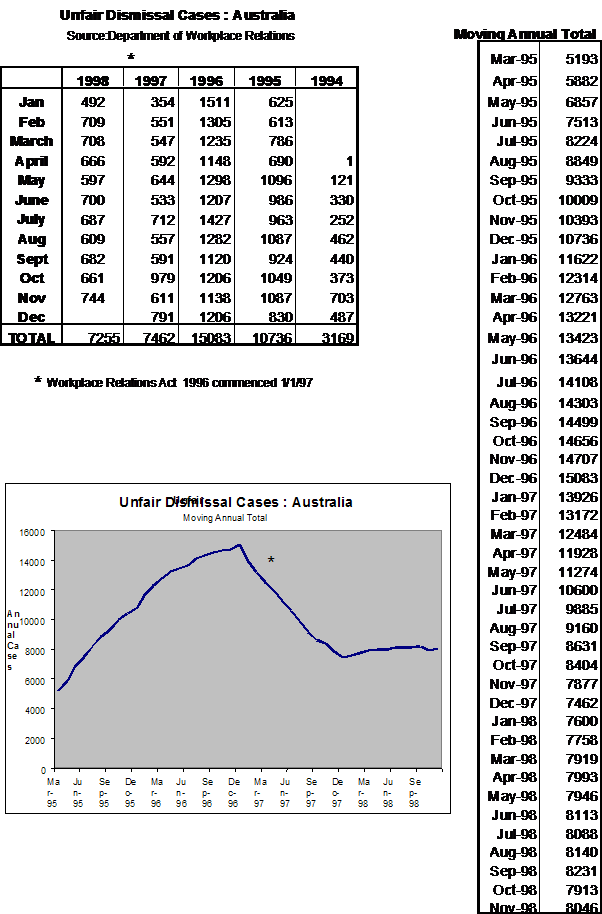
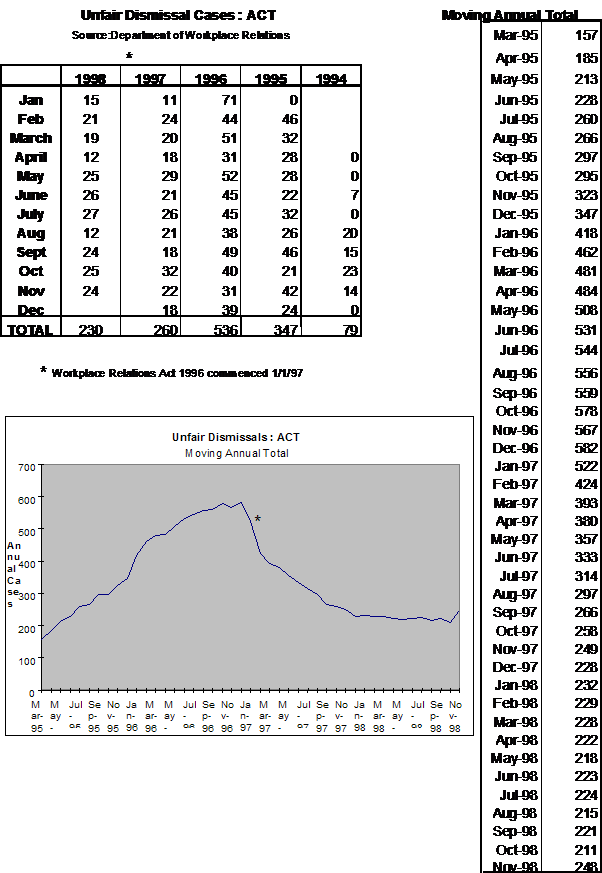
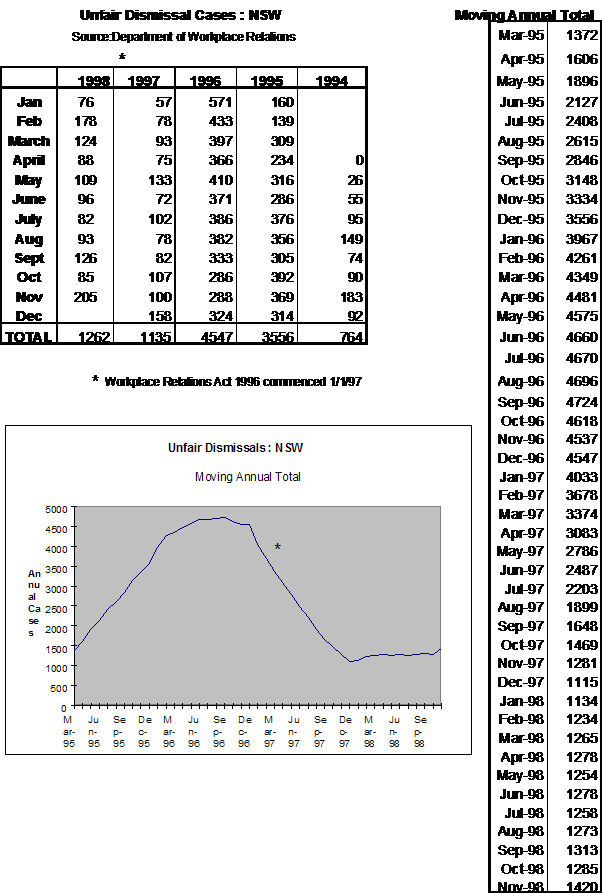
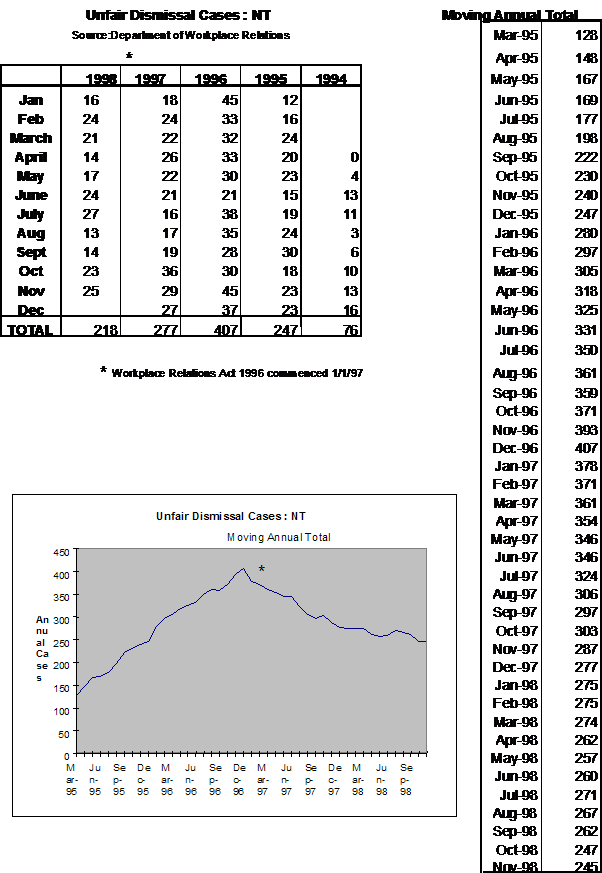
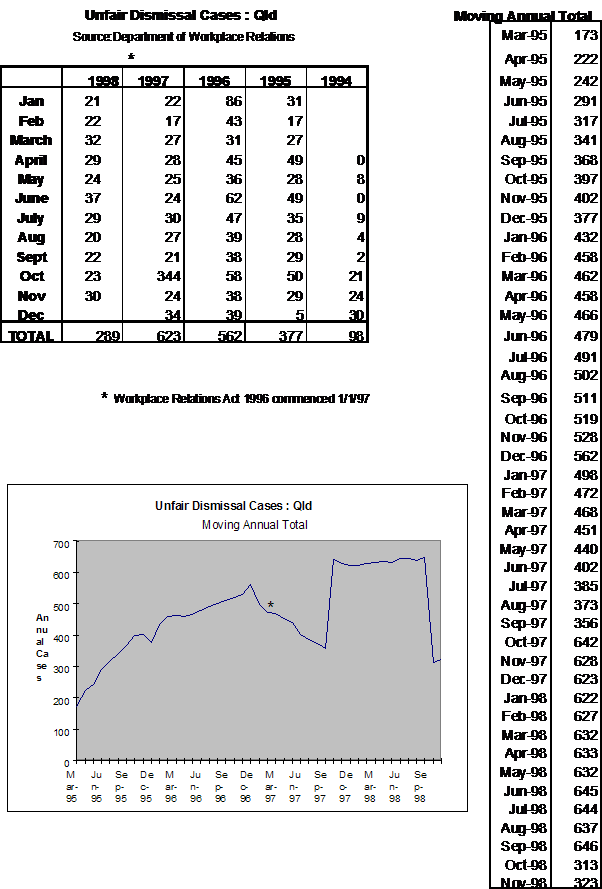
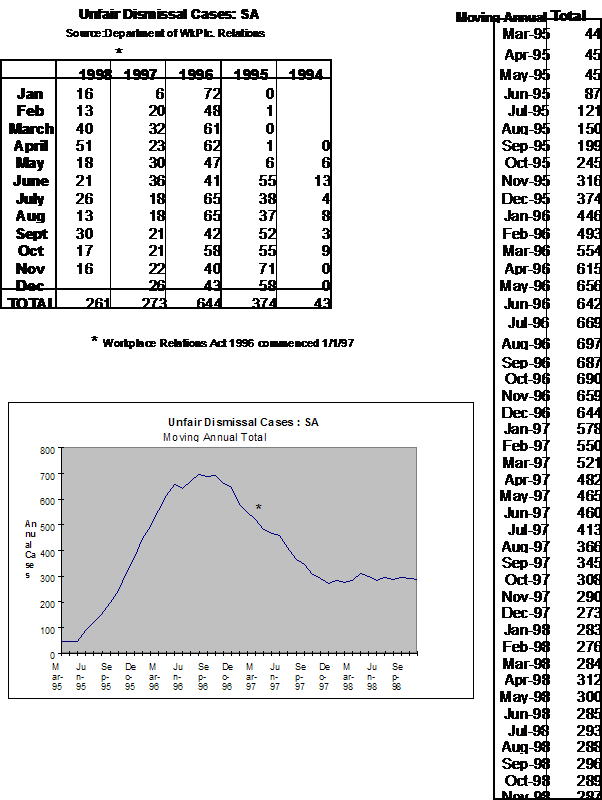
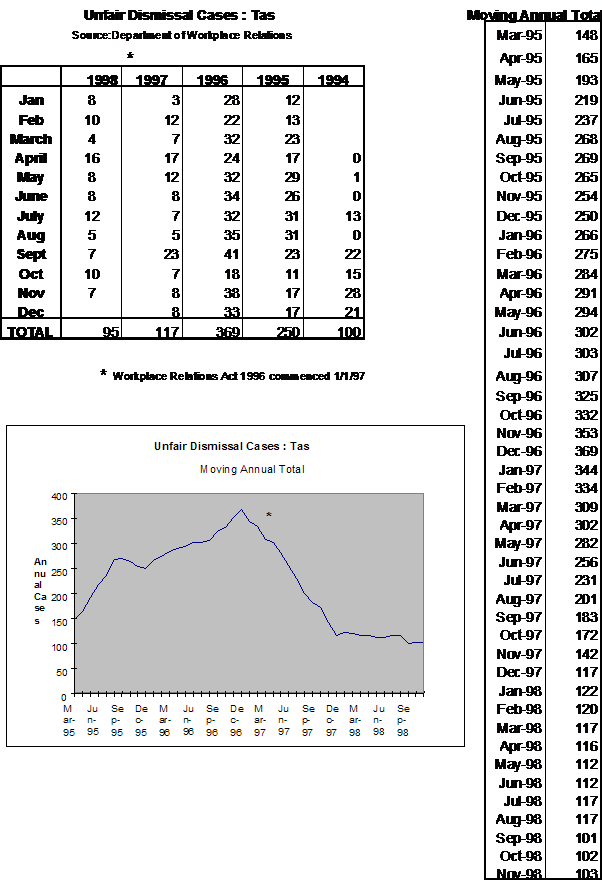
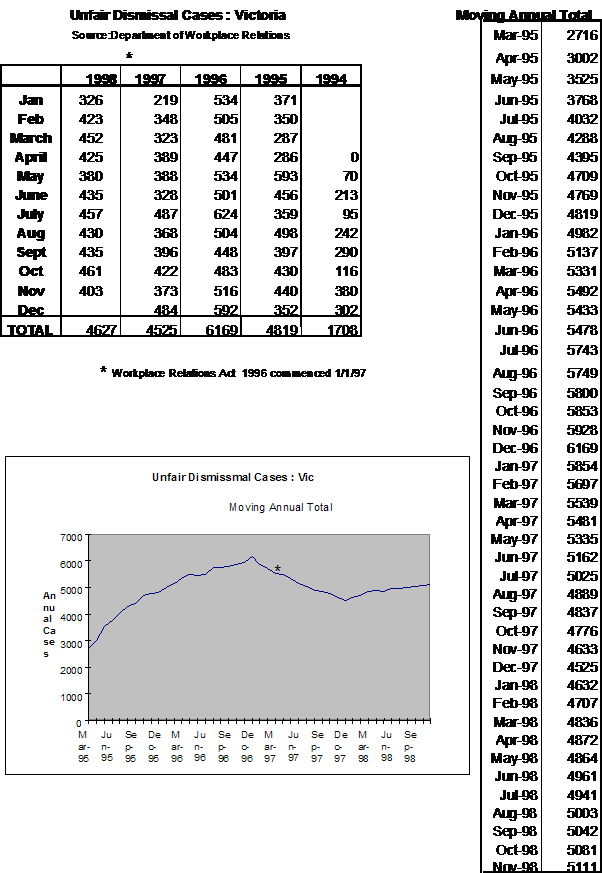
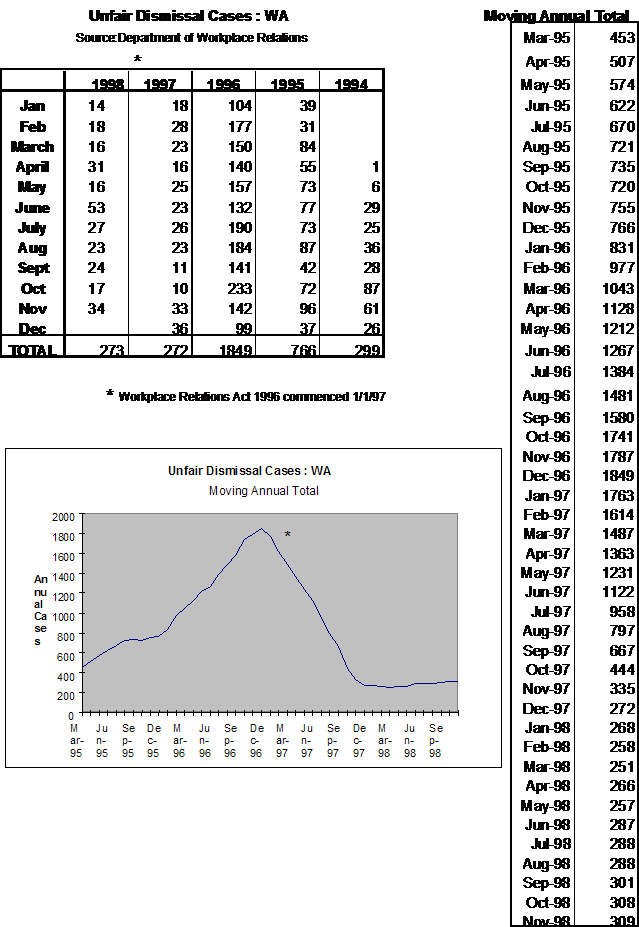
Appendix 4 – Question on Notice
MINISTER FOR EMPLOYMENT, WORKPLACE
RELATIONS AND SMALL BUSINESS
SENATE
(Question No. 10)
Senator Murray asked the Minister
representing the Minister for Employment, Workplace Relations and Small
Business, upon notice, on 10 November 1998:
- With reference to unfair dismissal claims under federal law, the
annual report for 1996-97 of the Industrial Relations Court of Australia
highlighted major outcomes in the federal jurisdiction as follows: (a) 74 per
cent of unfair dismissal claims cases were settled by agreement; (b) 75 per
cent of cases were finalised within 6 months and 99 per cent within 12 months;
(c) 62 per cent of trials were completed in one day and 84 per cent within 2
days; (d) 58 per cent of contested cases were decided in favour of the
employee, with 42 per cent in favour of the employer; (e) reinstatement of the
employee was ordered in 7.5 per cent of contested cases; and (f) the median
amount of compensation awarded was approximately $6 000:
Can comparable
information on unfair dismissal claims for the 1997-98 financial year be
provided for the following Jurisdictions: (a) Federal; (b) New South Wales; (c)
Queensland; (d) South Australia; (e) Tasmania; and (f) Western Australia.
- With reference to the Council of Small Business Organisations of
Australia's guess that 50 000 jobs would be created by exempting small business
employers employing 15 or fewer employees from federal unfair dismissal laws:
(a) how many of the estimated 50 000 jobs will be created in each state and
territory; and (b) can the methodology and empirical data used to arrive at the
jobs estimate creation in each jurisdiction be provided.
- With reference to the answer to paragraph (1) of question on
notice no. 1005 (Senate Hansard, 4 March 1998, p.421), for each of the
jurisdictions outlined in the table provided, can numbers be given, accompanied
by evidence and methodology for: (a) jobs created or lost as a result of
increases or decreases in unfair dismissal applications; and (b) separate
answers for federal, state and territory jurisdictions based on comparative
1996-97 data.
Senator Alston - The Minister for
Employment Workplace Relations and Small Business has provided the following
answer to the honourable senator's question:
- Answers for each of the five State unfair dismissal regimes
are unavailable. The 1997-8 Annual Report of the Australian Industrial
Relations Commission contains some statistics in relation to resolution of
unfair dismissal claims. However, the Australian Industrial Registry does not
collect data on all of the subjects on which the Industrial Relations Court of
Australia previously collected data. Therefore, statistics in relation to
federal unfair dismissal claims can only be provided for parts (a), (d) and
(e).
- There were 8 092 termination of employment applications lodged under
the Workplace Relations Act 1996 in 1997-98. Of those applications, 6 303
(78 per cent) were settled by agreement (ie had been withdrawn, settled or
otherwise discontinued prior to conciliation or settled at conciliation or
withdrawn, discontinued or otherwise settled after conciliation but prior to
final orders).
- There were 774 contested federal cases decided in 1997-98,
with 311 (40 per cent) decided in favour of the employer and 463 (60 per cent)
in favour of the employee. (It may be noted that 282 of the decisions in favour
of the employee involved applications against Gordonstone Coal Management based
on the same fact situation; if these 282 applications are treated as one class
action, then 63 per cent of contested cases would have been decided in favour
of the employer and 37 per cent in favour of the employee.)
- Reinstatement was awarded in only 17 (2 per cent) of the 774
contested federal cases.
- The Chief Executive of the Council of Small Business
Organisations Australia, Mr Rob Bastian, based his estimate that 50 000 jobs
would be created if small businesses were exempt from federal unfair dismissal
laws on the, in his view conservative, premise that 1 in 20 small businesses
would hire at least one more employee if the exclusion was to come into force.
Applying this
formula to the percentage of small businesses in each State or Territory
(according to data published in Small Business in Australia 1997, ABS Cat No.
132 1.0), approximately 16 500 jobs would be created in NSW, 12 500 in VIC, 9
500 in QLD, 4 000 in SA, 5 500 in WA, 1000 in TAS and 500 each in the ACT and
NT.
- Figures for the number of jobs created in each State and
Territory in 1996 and 1997 (trend series annual averages) are as follows.
(Source: ABS Labour Force Survey.)
|
|
NSW
|
VIC
|
QLD
|
SA
|
WA
|
TAS
|
NT
|
ACT
|
AUST
|
|
1996 ‘000
|
36.9
|
32.0
|
26.5
|
5.3
|
10.4
|
1.0
|
1.9
|
-1.9
|
112.5
|
|
%
|
1.3
|
1.6
|
1.8
|
0.8
|
1.3
|
0.5
|
2.3
|
-1.2
|
1.4
|
|
1997 ‘000
|
13.4
|
17.5
|
31.9
|
2.9
|
19.3
|
-6.8
|
1.9
|
1.6
|
80.7
|
|
|
0.5
|
0.8
|
2.1
|
0.4
|
2.3
|
-3.4
|
2.2
|
1.1
|
1.0
|
There are a number of factors that
contribute to the differences in labour market performance across the States
and Territories. For example, the States and Territories generally rely on
different industries for economic and employment growth. As such, any changes
in policy or economic conditions which affect sectors in a non-uniform
manner can be expected to have different impacts on employment. Similarly,
characteristics such as population size and growth, natural attributes and
climatic conditions also contribute to the differences in employment growth.
The reduction in the number of unfair
dismissal applications indicates that progress has been made under the current
legislation in discouraging inappropriate applications. This in itself would
not be expected to create additional jobs in the small business sector. The
Government considers that further change is required to recognise the
particular circumstances of small businesses as well as to provide greater
certainty for employers about the length of an employee's employment before
that person can initiate an unfair dismissal application (no change is proposed
in respect of unlawful dismissal applications). It is necessary to provide
security for employers that they will not be subject to inappropriate
applications. This is provided for in the Workplace Relations Amendment (Unfair
Dismissals) Bill 1998, presently before the Parliament.
Senator Andrew
Murray
Navigation: Previous Page | Contents